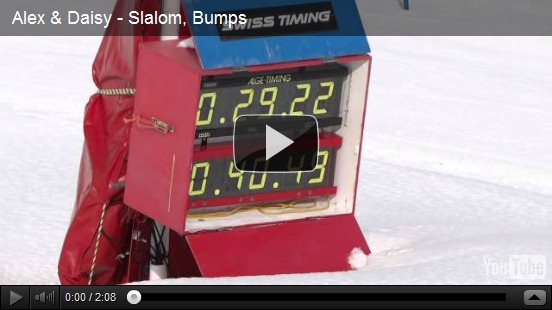Feet
Alex and Daisy were taught how to use their feet correctly for skiing for the first time this morning after finishing breakfast. They were only taught how to place the weight on the heels and rock the feet from edge to edge beneath the ankle joints. Along with this they were taught how to feel the adductor muscles on the inside of the legs – critical for appropriate coordination – especially during pivoting but for all skiing in general. Most people either instinctively or due to learning the snowplough tend to push the leg outwards, flattening the foot and using the muscles on the outside of the leg – but the correct coordination is the exact opposite. We applied this as soon as we began skiing, adding it to dynamics – rocking the feet towards the turn. I supported Alex and Daisy (substituting myself for the magic wall) so that they could feel the feet and the appropriate leg muscles statically before skiing. The idea was to do a couple of runs like this and head straight into the slalom before the course deteriorated.
Slalom
Alex and Daisy were asked to now apply this in slalom. Alex’s run of 40.49 seconds was no faster than yesterday and so I asked him what he had been thinking off. Alex started to reply “My feet and my leg….” but I stopped him! Me: “Alex, I got the impression that you were only thinking about going faster and forgot all the technique. Is that not true?” Alex: “Yes!” After that I was much more strict with Alex and pulled him up every time he showed signs of not listening to (or ignoring) instructions. Daisy on the other hand did listen and reduced her time by 6 seconds to 44.48 seconds. She still reverted to a racing snowplough but there was enough working to give her time a massive boost. Unfortunately it was too busy for them to make a second run without wasting too much time queuing.
Off Piste
We headed straight from the slalom to some steep off piste in soft snow. The skis lift you up much more easily in soft snow so the error novices make is to underestimate how much more it is necessary to move the body into the turn. The Magic Wall has to be used more strongly than on the piste so this is a good lesson – extending dynamic range naturally. Once dynamics are more or less in place then there is no difficulty in going off piste. Both Alex and Daisy were rapidly comfortable with their new environment.
Bumps
Slalom, Off Piste and Bumps are the three main areas of physical constraints that are used to develop skill – so from the top of the Tovière we went straight into bumps on a steep slope. I showed how the pivot can be used effectively with the ski tips being airborne over the crest of a bump – so the bump itself has a similar effect to jumping – getting the skis in the air. Daisy understood and used the bump to help the pivot but Alex didn’t listen and started jumping and turning almost at random. However it was their very first attempt. Daisy shows an impressive ability to pay attention and learn.
Adventure
After the bumps we continued off piste for their first really long excursion – right down to La Daille and using “la Familial” which was well ski pisted (though steep and bumpy) and “Piste Perdu” which is in the photographs…
La Face de Bellevarde – Black Run
We finished by skiing the whole of the Face which is a long, steep and relatively icy world famous black run. Daisy stopped only once but quickly overcame her worries and skied the entire run without any difficulty. Alex was already comfortable on steep terrain but Daisy has made great progress catching up. Alex will have to listen to instructions more if he is to remain ahead! (Latest update since this was posted: Alex 39.5 and daisy 40 seconds in slalom!)

